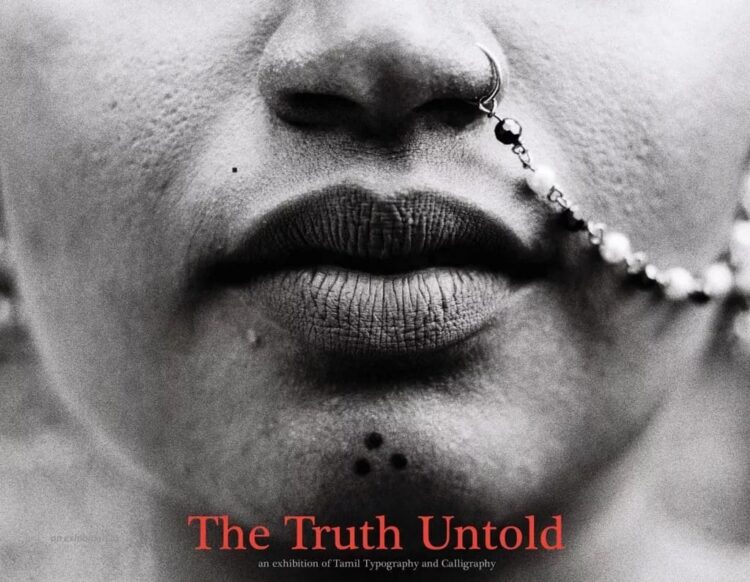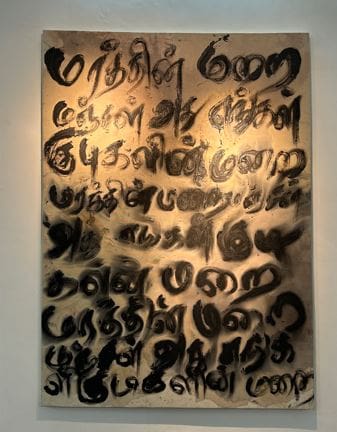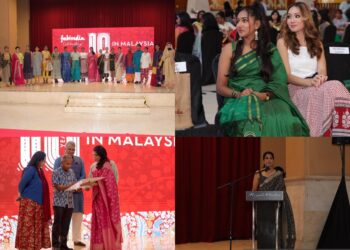The Truth Untold is an art exhibition that centres on the Tamil language in all its multitudes. The exhibition, which is curated by Stephen Menon at the Artvoice Gallery, will have its grand opening on November 18 at 7:30 p.m. and will be graced by Mr. Prabhakaran S. Nair, the founder of the Malaysia-India Heritage Society. The exhibition presents 20 artists that come from a diverse class of ethnic identities, artistic practices, aesthetic perceptions, and philosophical expressions. The exhibition, while centralising the Tamil language as an artistic essence, carefully expresses the distinct way in which each artist works, revealing their perspective and the rich, chasmic, and dialectical structure and sentience of the Tamil language and Tamil people. Here are some of the didactic artists and their artwork that will be featured in this exhibition.
Sharini Yogi‘s அடையாளம் (Identity)
“மரத்தின் மறை மஞ்சள் அது எங்கள் குடிகளின் மறை, (Marathin Marai Manchal Athu Engal Kudigalil Marai).”
In this guttural and brutal work by seasoned artist Sharini Yogi, the immense and painful weight of this ancient language is felt. Her work brilliantly wombs the metaphors of the history and presence of this language, that has given life to a people who, through all the odds and sufferings that have been cursed upon them, have continued to dare to exist. The artist, in a voice drenched in anger and vigour, screeches about the symbiotic nature between the bark of a tree protecting the forest and the Tamil language protecting the Tamil people’s identity, history, and culture. Her work is one that undeniably commands attention and thought; it captivates the onlooker with urgency and a haunting possession. As the letters descend from clarity into something more chaotic, it feels as if the language is approaching collapse, as if it is disintegrating into a pyre of smoke, like the ecological destruction around us. As vital as trees are to our existence, so is this language that births and nurses us. Her work calls out into the wild, of the need for this soul-bearing entity of a language, to be protected from extinction.
Poojitha Menon’s Letters From The Land
Poojitha’s work is a one that transcends the onlooker into a space of archeological and metaphorical explorations. She has meticulously placed cloth-like ceramic clay that evoke the scenery of excavation sights that have found Tamil inscriptions on ancient cloth materials. The piece is incredibly interactive, whereby it encourages the audience to walk around it and inspect the pieces as if they were an archaeological space themselves. The manner in which the clay was sculptured was also a synthesis between traditional and modern methodology, paralleling how the modern science of archaeological empiricism is imposed upon the past to analyse the history of an ancient people and their language.
Moly’s சுழலி (Suzhali)
A piece that took the artist nearly 2 years to complete, is another work that express beautifully and intricately the infinite subtilties of Tamil before the canvas, evoking the myriad, entangled, and amalgamated nature of the Tamil language and her people. Influenced by her Periyarist father, Dravidian philosophical thought, and her own devotion towards the language and people, Moly constructs glimpses of Tamil’s epochs in this breathtaking work of hers. Her work is mystical, entrancing, and critical in how it engages with the fabric of Tamil’s deep histories of theology, monarchies, and linguistic metamorphosis. The colours presented in her work exiles one into a corporal space of the rich soiled, earthly abundant, and rooted world of the language and people, while the bleeding of the stained red evokes the pained flesh of Tamils existence, which has bled at the hands of countless cruelties over the course of time.
Sanker Ganesh‘s Nanthi Karuppu
The Nandhi is a popular image that can be spotted in Sanker’s work, and in this art piece in particular, he expresses the mystical and cultural relationship that Tamil Hindu theology has with the Tamil language. The figures, which are depictions of the Tamil letter ‘ந’, seem to be dancing, elated, and entranced. The artist believes that this spiritual and cultural connection lives within all the descendants of the language and that no amount of change can alter the anatomical structure of the Tamil people, who have been deeply influenced by this spiritual and metaphysical world. The stark contradiction between the fiery ignited orange and the abyss like black, which signifies the predominant skin colour of Tamils, acts as a metaphor that the bodied black flesh of Tamils is one that bears the light of mystical rapture.
Lim Siang Jin‘s I won’t do it. Sorry | Naan Seyya Maatten Mannikkavum
Lim Siang Jin’s work is one that curiously ventures into the world of the Tamil script while in solidarity with Albert Camus’s ideology on rebellion. Jin’s work is a translation of the verse “I won’t do it. Sorry”, inspired by Albert Camus’ The Rebel, which was published in the early 1950s. Just as the historical period that Camus lived in was burdened with many violent and liberating changes against Nazism and colonialism, so are the present times with the ongoing war in Palestine at the hands of the genocidal occupying Israeli government. The need to rebel, to abide by one’s own principles, and to protect oneself and one’s own people is an integral value that has kept the Tamil language alive for this long. Jin even expresses that his own participation in this space is a form of rebellion, of beginning and engaging in meaningful dialogue.
Follow us on Instagram, Facebook or Telegram for more updates and breaking news.


















